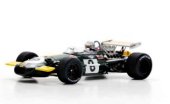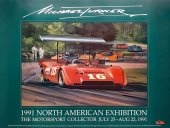ISSUE #25
ICOVER STORY
Audi Quattro in rallying 1980–87
An idea gives birth to Genius – Secret development phase 1978–1980
The winning begins – 1981–1982
A hard fight – The 1983 season
The greatest success – 1984
The quattro overtaken – Tougher competition in the WRC 1985–1986
A final fling – Group A entries 1987
First among equals – Michèle Mouton
An idea gives birth to genius
Secret development phase 1978–1980
To create the greatest revolution in the sport of motor rallying that was also one of the greatest advances in automobile safety of the late 20th Century, it took a request from the German Army, an inquisitive engineer, and an innovative Audi board member for technology.
The German Army had been expecting to get military vehicles from the Europa Jeep project, but when that collapsed in 1975, the German government turned to Volkswagen to design and build a jeep for them. It just so happened that VW was very busy with projects of their own – the Golf GTI and GTD – so in turn they handed the request over to Audi. The new jeep was given the project number ‘Typ 183’ and was to be powered by a 1.7-liter Audi engine driving all four wheels through an Audi 100 gearbox. It was given the name of Iltis. Naturally, Audi had to test it, and examples were taken to their annual winter sessions in northern Finland.
The engineer in charge of the tests – who also did quite a bit of the driving – was Jörg Bensinger. He noticed that on typical stretches of twisty, icy road, the Iltis despite its un-prepossessing shape, high center of gravity and relatively modest power was slightly quicker than Audi’s top-line front-wheel-drive models with more power and better handling. He was duty-bound to report this back to his boss in Ingolstadt, Jürgen Stockmar…
by John Davenport
Photographs: McKlein
The Quattro overtaken
Tougher competition in the WRC 1985–1986
In international rallying, there is no textbook that tells a motorsport department what their next step should be in order to keep up their winning momentum. Audi Sport already knew that there were two things that had elevated them to the top of rally sport: 4WD and turbo power. They decided to have more power and built the Sport Quattro with its 20-valve engine. But it was never going to be that simple, especially when its shorter wheelbase compromised handling in a car that was already front-heavy and was having to compete against better balanced and more sophisticated 4WD turbocharged cars.
The commitment from Audi Sport for 1985 was that the A2 would not be used any more as a works car. The driver line-up was to be focussed on Blomqvist and Röhrl, with Mikkola taking something of a back seat while Michèle Mouton would do some European championship events.
If it had not been for Peugeot’s 205 T16, Audi might easily have won another Monte Carlo Rally, but this year started the same way the last one had finished: with a win for Vatanen and Peugeot. Röhrl was second in an S1 with another 205 T16 third and Blomqvist fourth in the other S1. At one point, halfway through the rally, it looked as if Vatanen’s co-driver had gifted Röhrl a fifth Monte win when he checked in at a time control four minutes early. That is equal to eight minutes of time on the stages, so the Peugeot crew needed a massive catch-up. They were helped when Röhrl chose to go on racing tyres for stage twenty-seven – eight kilometres uphill on snow and ice followed by twenty-six on a wet tarmac road. Racers must have seemed like the right option for the Audi, but when Vatanen, driving on lightly studded snow tyres, passed Röhrl after only a few kilometres, it was clear that the tyre choice had been wrong…
by John Davenport
Photographs: McKlein
First among equals
Michèle Mouton
When Michèle Mouton won four WRC rallies in her first two years driving with Audi, it was seen by some as a statement about the ability of women drivers to be like the men. For Mouton, it was nothing of the kind. Twenty years later she said: ‘For me, men and women are different. I want to stay a woman. I don’t want to be a man. I don’t want them to be a woman, either. I just wanted to be good. My motivation was my honour, my pride in my own ability.’
Mouton’s rally career started off as a co-driver to Jean Taibi in a Peugeot 304S on the Monte Carlo and other rallies in 1973. In November 1974 she was behind the wheel of her own Alpine Renault A110 doing the Tour de Corse national rally. This was largely thanks to her father who had taught her to drive when she was fourteen. He was a major supporter of her rally career and told her: ‘I will buy you a car. You will do some rallies to see how you go. Next year, I will pay for one year.’ His enthusiasm sparked her determination to do well: ‘He and my mother came to all the rallies.’
During 1974 and 1975, she did a full programme of French rallies, finishing second and third overall in the French championship and winning the Ladies’ Cup on both occasions. Then she was offered a factory car paid for by Elf Petroleum, but with no salary, only expenses. For 1977, she started driving an Alméras Porsche and racked up a trio of second places – including the Tour de France behind Bernard Darniche’s Lancia Stratos – and then won the Spanish Rally, a round of the European Championship. This brought her to the attention of Fiat, and she drove a 131 Abarth for them to eighth place on the Tour de Corse…
by John Davenport
Photographs: McKLein, Motorsportimages
March’s Big Banger
March 707 and 717
Hot, sunny weather shone down on Nuremberg on the 28th of June in 1970. As usual, perfect conditions for the annual Norisring event. The highlight of the weekend were the 200 Miles of Nuremberg, which featured two important debuts. One was the first race of the newly-created Interserie for two-seater sports cars meeting regulations for Groups 5 to 7. The other was a brand-new Group 7 racer, which turned its first competitive laps on the famous German street circuit.
What do you do when you’ve signed a world-class driver but can’t afford to pay him the agreed salary? Well, 50 years ago the solution was to build him a car he could race, and therefore earn money with, elsewhere. That’s precisely what happened with new manufacturer March, only formed in 1969, and its works driver Chris Amon in 1970. Thanks to the promise of a princely wage, March founders Robin Herd and Max Mosley had lured the 26-year-old Kiwi from Ferrari to drive the March 701 in Formula 1. Amon was at the time acknowledged as one of the best F1 drivers in the world, despite having famously never won a Grand Prix. As it would turn out, he never would.
What Herd and Mosley didn’t know was how they were going to raise the money to pay Amon. When his salary was due and the cash wasn’t there, March offered to instead build Amon a sports car that he could use in the lucrative Can-Am series in North America to earn some prize money. The New Zealander liked the offer, sensing it could be the first step toward his own Amon Racing squad in the future…
by Harold Schwarz
Photographs: Motorsportimages, McKlein, Sammlung Robert Weber/Helmut Wenz, Ferdi Kräling, Nils Ruwisch, Lionel Birnbom
Aiming for the Top Le Mans ’66
The success of the Porsche 906 LH
The 1966 24 Hours of Le Mans are best known for the titanic battle between Ford and Ferrari. It ended in a one-two-three for the Americans and has since become the subject of a Hollywood movie. However, the remarkable results for another car, which both won the two-litre prototype class and also secured fourth to sixth outright, caught the eyes of experts as well. It was Porsche’s 906 LH (‘Langheck’, German for ‘long tail’), of which only three were built. AUTOMOBILSPORT took a closer look at one of them at the Porsche Museum.
While Porsche took four major outright wins in long-distance sports car races between 1959 and 1963 with three different versions of the 718 – one at Sebring in 1960 and three at the Targa Florio in ’59, ’60 and ’63 – the German manufacturer was primarily considered a candidate for two-litre class wins at the time. Effectively, the race cars were all based on the 356.
When thoughts turned to a successor for the 356, a new technical dawn for the sporting programme beckoned. The Formula 1 project had been shelved due to lack of success, with Porsche’s focus returning to the World Sportscar Championship and the European Hillclimb Championship. The numbers told the story. Parallel to the 911, developed as the 901, the 904 was created to go motor racing. The 904 was Ferdinand Alexander ‘Butzi’ Porsche’s design masterpiece, and is regarded as the starting point to a development thread that led to the outstanding 917 at the beginning of the 1970s…
by Thomas Nehlert
Photographs: Porsche, Alexander Babic, Motorsportimages
- Eckhard Schimpf on Günther Isenbügel
- John Davenport about Renault Sport Germany
- Jo Ramirez on Ricardo and Pedro Rodríguez
- Norbert Singer about Weissach 1971
- Mac Surer about Le Mans 1978
- Back on Track BMW F268/1
- and many more!




